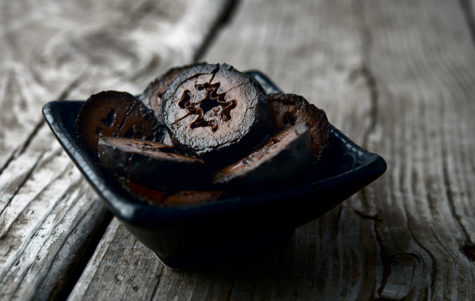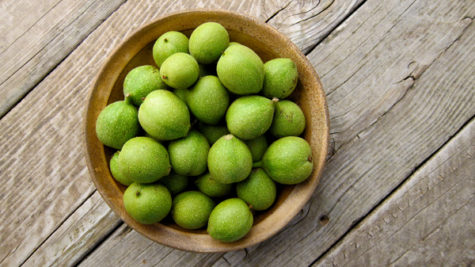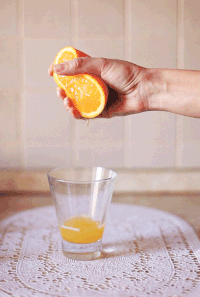Pickled Walnuts
What do you do with them? They are particularly good with cheddar, and in Britain they are traditionally part of a ploughman’s lunch, with other pickles, cheese and cold meats. They can also be tossed into beef or lamb stews (pot pies and pasties, too!) in wintertime, and in summertime served in cool salads alongside tomatoes, and accompanying shellfish such as scallops or shrimp.
The flavor is a bit like eating solid steak sauce, with a little floral aroma and a zephyr of bitterness that just barely let you notice it. Eaten alone they are fairly soft, puckery and strangely floral with a Worcestershire-Heinz 57 taste to it.
For the recipe you need green, unripe walnuts to make pickles. And yes, you use the whole thing, hull and all.
It is very important that you test to see that the walnuts are green enough to use. How to do this is slice an unripe nut in half. You need to do this, either with a knife or a stout needle or a long nail, because you have to catch the unripe walnuts before the shell forms. Once that shell forms inside the walnut’s hull, you’re too late.
The traditional harvest date in England is late June.
Any walnuts will work with this recipe, from tiny native Arizona walnuts to big, fat English walnuts, which are the kind you buy in stores. But you do need them hull and all, so this only works if you have a tree nearby.
The process for pickling walnuts is not hard at all, but it takes more than a week. You need to brine the green walnuts for a good long time before they will be ready to pickle properly. The brine time helps with preservation and removes some of the bitterness in the unripe walnuts. Once brine pickled, they are pretty durable. Do you need to sun-blacken the walnuts? No, but doing so gives you a nice, uniform look to them. Otherwise they will be olive green in some places, blotchy black in others.
The pickling liquid in my recipe is very traditional; you’ll see variations on it throughout England. I’ve also made a Chinese-inspired version with Sichuan peppercorns and star anise replacing the allspice.
Makes about: 3 to 4 quarts.
Prep Time: 8 days, fermenting time
Cook Time: n/a
- About 50 to 60 green, unripe walnuts
- 1/2 cup kosher salt
- 1/2 gallon water
- 2 quarts cider or malt vinegar
- 1 tablespoon cracked black pepper
- 1 tablespoon cracked allspice berries
- 10 cloves
- 1 ounce ginger, smashed (about 1 1/2-inch pieces)
- 1 cup brown sugar
Instructions:
- Dissolve the salt in the water to make a brine. Put on some rubber gloves if you have them, because walnut juice will stain your hands for weeks — and it won’t come off. Trust me on this one. Properly gloved, stab each walnut with a fork in several places; this helps the brine penetrate. Submerge the walnuts in the brine and let them ferment for 8 days at room temperature.
- Remove the walnuts and put them on a baking sheet and leave them outside in the sun for a day, until they turn uniformly black. You can do this step without gloves if you want.
- Pack the walnuts into quart jars. Bring the remaining ingredients to a boil and pour over the walnuts. Leave very little headspace in the jars. Seal and keep in a cool place, either the fridge or a basement — you just want them to rest below 70°F — for at least a month before you eat them. Kept this way they will last a year.
Note: When you use the walnuts in recipes or for lunches, be sure to keep the vinegar as it is said to be a great gargle for coughs when you have a cold or the flu.
From: Honest Food





Leave a Reply